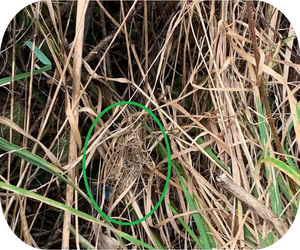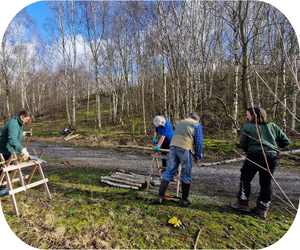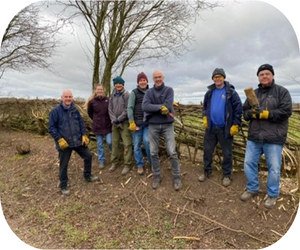Trail tales - March 2024

A monthly update from the Warwickshire Country Parks rangers
Harvest Mouse Survey at Ryton Pools Country Park
By Ben Coleman, Grassland Habitat Specialist Ranger
On Saturday 3 February, we were joined by a team of fourteen volunteers from the Warwickshire Mammal Group in a hunt for the Harvest Mouse at Ryton Pools. Harvest Mice are red-listed due to their declining numbers, and this is the third winter of the National Harvest Mouse Survey which aims to better understand their distribution and habitat usage. Some of our meadows and path verges at Ryton Pools are purposefully left to grow long to support a range of wildlife and we were hoping that Harvest Mice may be among them!
Harvest Mice generally need vegetation taller than 40cm long to nest in, so verges and field margins give the best chance of finding the (abondoned) intricately-woven grass nests used for breeding last summer. However, reed beds, ditches and hedgerows can also provide suitable habitats.
Ranger  Courtenay worked with the volunteer team in our smallest and most suitable meadow for the species. Despite the best efforts of the team, no nests were found in that meadow - this may be because the grasses were not quite tall enough to facilitate nesting. As the team were heading back somewhat despondently for a hot drink after a difficult morning searching, one of the experts in the team, Dr. Debbie Wright, stopped off to look at some suitable habitat next to the picnic meadow. After a few minutes of searching, she discovered a partially formed nest among some of the long vegetation!
Courtenay worked with the volunteer team in our smallest and most suitable meadow for the species. Despite the best efforts of the team, no nests were found in that meadow - this may be because the grasses were not quite tall enough to facilitate nesting. As the team were heading back somewhat despondently for a hot drink after a difficult morning searching, one of the experts in the team, Dr. Debbie Wright, stopped off to look at some suitable habitat next to the picnic meadow. After a few minutes of searching, she discovered a partially formed nest among some of the long vegetation!
Now we have evidence of the species on-site we are in the process of identifying further, more suitable habitat to see if we can better understand the distribution of Harvest Mice across the site.
A big thank you to all the volunteers from the Warwickshire Mammal Group for their help on the day!
Woodland Management at Pooley Country Park
By James Taylor, Woodland Specialist Ranger

The Warwickshire Country Parks team all got together for fantastic day doing some important woodland management at Pooley Country Park.
Some of the team worked on the grassland, trimming Silver Birch saplings to create space for grasses and wildflowers to thrive. Other colleagues worked on removing some Silver Birch trees that were hanging over the path and creating a potential hazard, as well as removing some to make room for English Oak, a technique known as 'halo thinning'.
The felled trees were then chopped up and used to create habitat piles, providing the perfect home for many woodland species.
Please don't remove any logs from our country parks due to their important habitat value.
Hedgerows and Helping Hands - Working Together to Conserve the Hedgerows of Ryton Pools
By Craig Earl, Senior Ranger (South)
There is more to the humble hedgerow than meets the eye.
They have been part of the fabric of our countryside for over three thousand years, since Bronze Age farmers hewed clearings from the wildwood leaving thin strips of woodland between them, forming the first hedges.
They have known mixed fortunes since, extending or contracting in accordance with the politics of the era. They have even had a role to play in some of our most tumultuous periods: the Saxons and Normans removed many of the Bronze Age hedgerows, but Medieval and Tudor times saw a huge upsurge in planting during the ‘enclosures’.
To the modern ear, more hedges sounds rather positive, but in the context of the time it came at horrendous human cost. The peasantry’s livelihood depended on access to the open land; when this was denied to them, they were forced to cultivate small, unproductive scraps of ground, and many starved.
As a bit of regional interest, the Midland Revolt of 1607 saw thousands of citizens, collectively known as ‘The Levellers’, tear up hedgerows in protest.
Fast forward into more contemporary times, shortly after WWII legislation was introduced incentivising the removal of hedgerows to maximise food production. This had a profound effect on our modern-day rural landscape and its wildlife.
In 1950, we were estimated to have one million km of hedgerow. By 2007, over 530,000km of this had vanished.
Averaged out, that is over nine thousand kilometres of hedgerow lost every year, for over half a century - a sobering statistic.
However, this loss sharpened our collective focus on the intrinsic ecological value of hedges, and thankfully, in 2006 hedgerows were recognised as ‘habitats of principal importance for biodiversity conservation’.
This is the context in which all of our hedgerow enhancement work takes place at Ryton Pools Country Park.
Over the last eight years, we have worked with the Dunsmore Living Landscape Project (led by Warwickshire Wildlife Trust) to plant upwards of twenty-eight thousand mixed hedgerow trees. Supported by many amazing volunteers, this work has created or enhanced nearly two miles of hedgerow. Some of these recent plantings are already burgeoning into valuable habitats.
One of the key aims of the Dunsmore Living Landscape project was to create patches of wildlife habitat that are better connected together across the landscape, helping wildlife to disperse more widely. Hedges help provide this connectivity by providing a secure, sheltered route for wildlife to travel along, linking these habitats together.
Working in close partnership with the Warwickshire Branch of Butterfly Conservation, we have increased populations of the Brown Hairstreak butterfly using just this approach. This rather nondescript but uncommon butterfly is a fussy breeder. It will only lay its eggs in the branch axils of young blackthorn trees. Ensuring blackthorn is present in new hedges, and managing them sympathetically, provides these rare butterflies with egg laying opportunities while allowing them to increase their range into new areas.
In a very real sense, a well-maintained hedgerow can be thought of as a conduit of biodiversity through the landscape. A staccato current of wildlife flows through them. They are vibrant, dynamic habitats that can underpin the ecological health of the wider landscape.
Not all of Ryton’s hedges are new. Some are mature enough to need active management.
Hedge laying is a traditional method which has been practiced for centuries, and we have approximately six hundred meters of hedgerow which we manage in this way on a seven-year rotation.
Hedge laying strengthens and prolongs the life of the hedge. It’s a staple of our winter works program, and eagerly anticipated by our regular volunteers.
In essence, it involves cutting most of the way through the stems and leaning them over, leaving enough of a hinge of living tissue connecting the roots to the now horizontal stem.
Once the stems are down, they are reinforced with hazel stakes at half meter intervals, which are then held straight with willow binders, twisted around one another to form a braided spine. The finished article is aesthetic as well as ecologically beneficial, often drawing visitors into conversation as we progress.
It is absorbing work. With billhook in hand, the world shrinks to nothing more than the stem you are working on. ‘Mindful’ is an overused term these days, but hedge laying certainly qualifies.
No wonder, then, that it is such a popular task with volunteers. At this point, it seems only appropriate that we hear from them in their own words:
I enjoy hedge laying because it is working with nature to provide a sustainable barrier which looks good and is practical. There is also a pride in producing a something that will last and give pleasure to visitors to the park. From comments I have had, people appreciate the effort made by the Rangers and the Volunteers in keeping the park tidy and trimmed.
It also keeps those skills alive that have been around for centuries and gives me a sense of continuity (as well as a good workout, especially weaving the bindings!)
Dave
I have loved learning more about the historic art of hedgelaying. It is a fascinating process and I can’t quite believe that cutting the stems so severely then bending them will actually result in a better hedge. It’s hard work but is so satisfying knowing that the finished hedge will be stronger, healthier and provide a great habitat for wildlife.
Dave and Phil were excellent teachers and I look forward to the next time I can practice those new skills.
Sara
The volunteers beside their finished hedgerow. From left to right, Dave, Sara, Phill, Toby, Paul, Chris and Ian.
With guidance from the country park rangers, along with those volunteers with previous experience, I had the opportunity to have a go at part of the hedgelaying program at Ryton Pools.
Whilst not as easy as it looks(!), it was fabulous to learn a new skill and produce something that hopefully will be there for some years into the future.
Andy


We finished this winters’ section of hedge in early February, and no sooner had the final binding been applied than the first flowers opened. The Cherry Plum is precocious with its blossom, heralding spring in extrovert fashion with a froth of glacial white on naked branches. With little colour elsewhere, the display is stark and joyous.
A succession of tree species will erupt into bloom over the coming weeks, creating an unbroken timeline of forage for pollinating insects into the summer. As one species’ flowers fade, another takes the baton in a process that has coined one of the most enchanting terms in conservation: blossom sequence.
A mixed species hedge is the perfect illustration of blossom sequence. A key reason we have tried to ensure that the right variety of trees are present in our recent planting schemes is to maximise this crucial benefit to pollinators.

The fact that it also happens to be beautiful is, of course, very welcome! In the words of A E Housman:
‘Loveliest of trees, the cherry now,
Is hung with blooms along the bough…….’
So, if you visit Ryton Pools over the coming weeks, and you pass a wayside tree hung with Housman’s blooms, why not pause a moment to inhale the sweet, unrefined scent of a Spring hedgerow?



